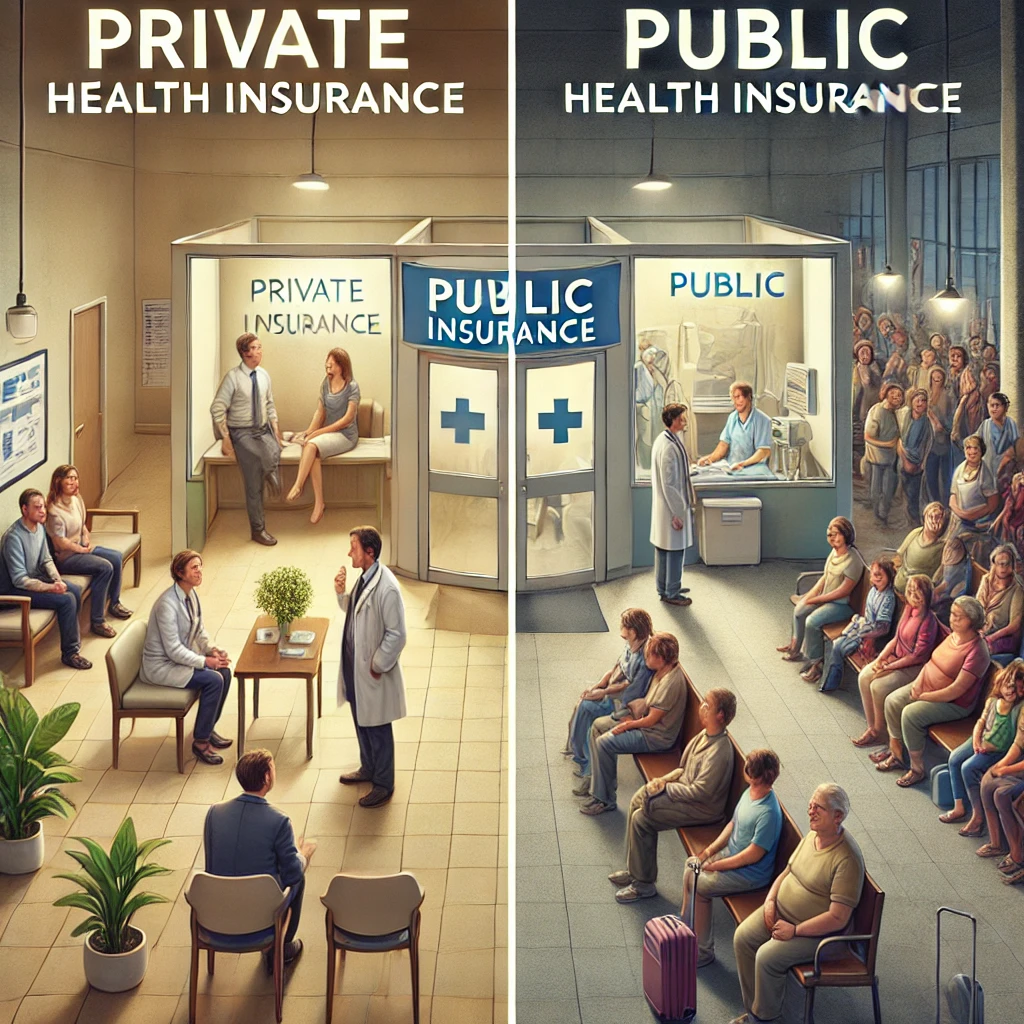Choosing between private health insurance and public insurance is a critical decision that impacts healthcare access, costs, and quality of care. While public insurance is government-funded and aims to provide affordable healthcare to a broad population, private health insurance is offered by private companies and generally provides more extensive options. Understanding the differences, benefits, and drawbacks of both types of insurance can help individuals make an informed decision.
Understanding Private Health Insurance
What is Private Health Insurance?
Private health insurance is coverage provided by private companies, employers, or purchased individually. It comes with different plans, pricing, and coverage levels, offering flexibility and additional healthcare services.
Types of Private Health Insurance
- Employer-Sponsored Plans – Many employers provide private health insurance as part of employee benefits, often covering a portion of the premium.
- Individual and Family Plans – Individuals who do not receive insurance through their employer can purchase private health plans directly from insurance companies.
- Marketplace Insurance Plans – Available through state and federal exchanges, these plans comply with the Affordable Care Act (ACA).
Benefits of Private Health Insurance
- Greater Choice of Providers: Patients can select from a wider network of doctors, hospitals, and specialists.
- Shorter Wait Times: Access to quicker medical appointments, elective procedures, and specialist consultations.
- Comprehensive Coverage Options: Plans often include dental, vision, and alternative medical treatments.
- Customization: Individuals can tailor plans based on specific healthcare needs and budget.
Drawbacks of Private Health Insurance
- Higher Costs: Monthly premiums, deductibles, and copays are typically more expensive than public insurance.
- Complex Policies: Understanding terms, conditions, and coverage limitations can be challenging.
- Pre-Existing Condition Considerations: Although ACA-compliant plans cover pre-existing conditions, non-compliant private policies may not.
Understanding Public Health Insurance
What is Public Health Insurance?
Public insurance is government-funded healthcare coverage designed to provide medical services at little to no cost. It is available to eligible individuals based on age, income, and other criteria.
Types of Public Insurance in the U.S.
- Medicare: A federal program for individuals aged 65 and older and those with disabilities.
- Medicaid: A joint federal and state program offering low-income individuals and families access to medical services.
- Children’s Health Insurance Program (CHIP): Covers children in families with incomes too high for Medicaid but too low for private insurance.
- Veterans Health Administration (VA) Coverage: Provides healthcare benefits to military veterans.
Benefits of Public Health Insurance
- Lower Costs: Public insurance plans typically have lower or no premiums, deductibles, and out-of-pocket expenses.
- Broad Coverage: Many essential health services, including preventive care, are covered.
- Guaranteed Acceptance: Eligible individuals are accepted regardless of pre-existing conditions or employment status.
Drawbacks of Public Health Insurance
- Limited Provider Networks: Only specific doctors and hospitals accept public insurance.
- Longer Wait Times: Patients may face delays for specialist visits and elective procedures.
- Income and Eligibility Restrictions: Public programs have strict eligibility requirements that not all individuals meet.
Key Differences Between Private and Public Insurance
| Feature | Private Insurance | Public Insurance |
|---|---|---|
| Cost | Higher premiums, deductibles, and out-of-pocket costs | Lower or no premiums, minimal out-of-pocket costs |
| Provider Choice | Wider network of doctors and hospitals | Limited to government-approved providers |
| Wait Times | Shorter wait times for specialists and procedures | Longer wait times for non-emergency treatments |
| Eligibility | Available to anyone who can pay | Limited to age, income, or disability requirements |
| Coverage Options | More flexibility, additional benefits (dental, vision) | Covers essential medical needs but limited flexibility |
Cost Comparison: Private vs. Public Insurance
The cost of health insurance varies widely depending on the type of plan and coverage. Here’s a general cost breakdown:
- Private Insurance Costs:
- Monthly Premiums: $450-$1,200 (individual) / $1,150-$2,500 (family)
- Deductibles: $1,500-$5,000 per year
- Copayments and Coinsurance: 10-30% of medical costs
- Public Insurance Costs:
- Medicare Part A: Free for most, but can cost up to $506/month (2024 figures)
- Medicare Part B: Standard premium of $174.70/month (2024)
- Medicaid: Often free or low-cost based on income
- CHIP: Low-cost coverage, typically $10-$50/month per child
Who Should Choose Private Insurance?
Private health insurance is ideal for individuals who:
- Prefer a wider choice of doctors and hospitals.
- Need immediate access to specialists and elective procedures.
- Can afford higher premiums and out-of-pocket costs.
- Require specialized healthcare services or treatments not covered by public insurance.
Who Should Choose Public Insurance?
Public insurance is a better option for:
- Seniors (Medicare eligibility) or low-income individuals (Medicaid eligibility).
- Those who cannot afford private insurance premiums and deductibles.
- People with chronic illnesses who need continuous medical care at a lower cost.
- Individuals who qualify for government-funded programs due to disability or veteran status.
Hybrid Approach: Combining Private and Public Insurance
Some individuals opt for both private and public insurance to maximize coverage. For instance:
- Medicare Advantage Plans (Part C) allow seniors to purchase private insurance that complements Medicare.
- Medicaid and Private Plans – Some individuals qualify for Medicaid while holding private insurance for additional benefits.
- Employer-Sponsored Insurance with Medicare – Retirees may use both employer-sponsored coverage and Medicare for broader benefits.
The Global Perspective: Private vs. Public Insurance Worldwide
Other countries use different models of private and public insurance:
- Canada: Primarily public insurance with private options for additional services.
- United Kingdom: National Health Service (NHS) provides universal public coverage, but private insurance offers faster treatment.
- Germany: A mix of public (statutory health insurance) and private plans, allowing citizens to choose their coverage level.
Conclusion: Making the Right Choice
Both private health insurance and public insurance offer essential healthcare benefits, but the best choice depends on individual needs, budget, and eligibility.
- Private Insurance is ideal for those who can afford higher costs and want more provider options and shorter wait times.
- Public Insurance is a great option for those who qualify and need lower-cost healthcare.
- A hybrid approach might work best for those who want the benefits of both systems.
Understanding the distinctions between these options ensures individuals and families make informed decisions regarding their healthcare coverage.
External Links:


